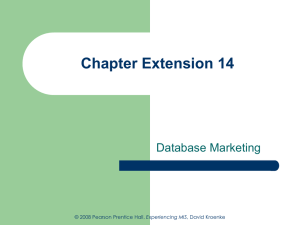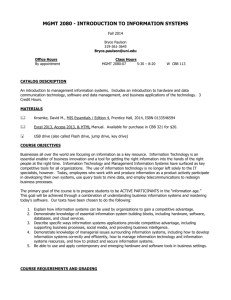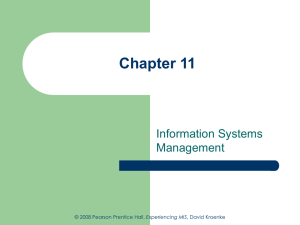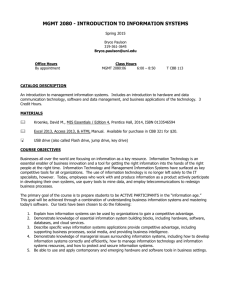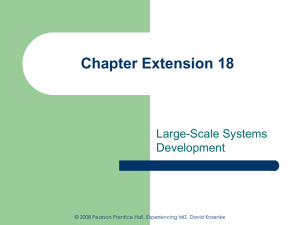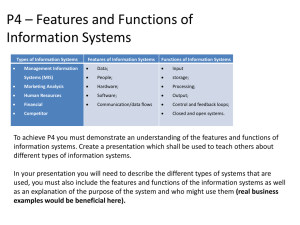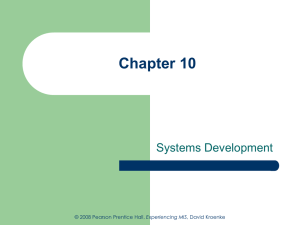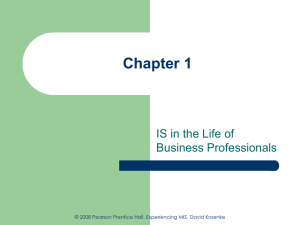CE10
advertisement
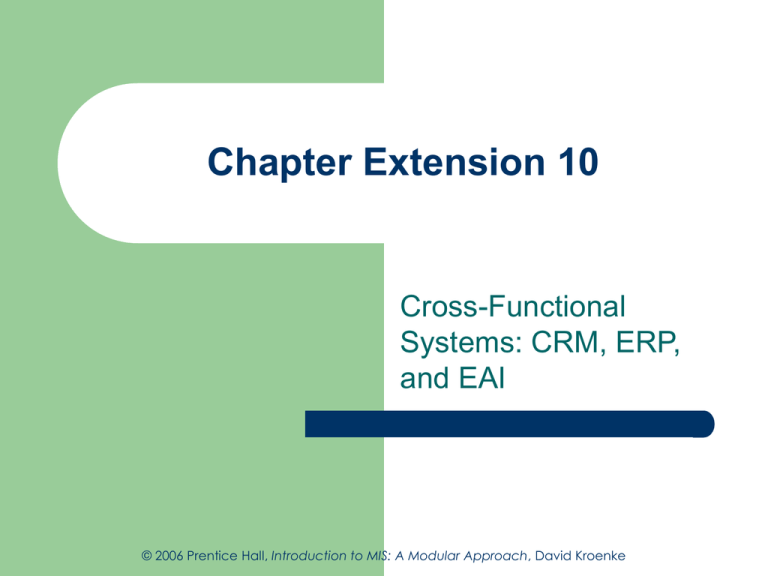
Chapter Extension 10 Cross-Functional Systems: CRM, ERP, and EAI © 2006 Prentice Hall, Introduction to MIS: A Modular Approach, David Kroenke Study Questions What is the importance of inherent processes? What are the characteristics of customer relationship management (CRM) systems? What are the characteristics of enterprise resource planning (ERP) systems? How is an ERP system implemented? What are the characteristics of enterprise application integration (EAI) systems? © 2006 Prentice Hall, Introduction to MIS: A Modular Approach, David Kroenke Business Process Design Business process redesign – – Organizations should not automate or improve functional systems Organizations should create new business processes Came from idea that information systems should support linkages across departments and activities © 2006 Prentice Hall, Introduction to MIS: A Modular Approach, David Kroenke Challenges of Business Process Design Projects expensive and difficult – – – – – Systems analysts interview personnel, document existing systems Managers review results, develop new process New information systems developed Takes time Underlying systems constantly changing Employees resist change Outcome uncertain © 2006 Prentice Hall, Introduction to MIS: A Modular Approach, David Kroenke Benefits and Disadvantages of Inherent Processes Business applications – Processes for using software are inherent Benefits – – – Integrate activities across departments Saves time Saves money Reduces design process problems Disadvantages – Organizations must conform activities to processes May have to change substantially © 2006 Prentice Hall, Introduction to MIS: A Modular Approach, David Kroenke Organizational Change Common problem has produced change management industry – – – Blend of business, engineering, sociology, psychology Strives to understand dynamics of change Develop theories, methods, techniques Employee resistance – – – – Need to understand rationale for new system Fear of unknown Increase employees’ sense of self-efficacy Bosses’ behavior and communication important © 2006 Prentice Hall, Introduction to MIS: A Modular Approach, David Kroenke Customer Relationship Management Systems (CRM) Support processes of attracting, selling, managing, delivering, and supporting customers Addresses all activities that touch customers Single repository for customer data Customer life cycles – – – – Marketing sends messages to target market Prospects order and need to be supported Support and resale increases value to existing customers Win-back processes categorize customers according to value © 2006 Prentice Hall, Introduction to MIS: A Modular Approach, David Kroenke Customer Life Cycle Figure CE10-2 © 2006 Prentice Hall, Introduction to MIS: A Modular Approach, David Kroenke Components of CRM System Solicitation – Lead-tracking – Supporting system is email and organization’s Web site Presale applications turn prospects into customers Relationship management – – Maximize value of existing customers Sales management applications help develop strategies for regaining lost customers © 2006 Prentice Hall, Introduction to MIS: A Modular Approach, David Kroenke CRM Components Figure CE10-3 © 2006 Prentice Hall, Introduction to MIS: A Modular Approach, David Kroenke Enterprise Resource Planning Systems (ERP) Support business processes, human resources, account support processes Enterprise-wide Cross-departmental process systems Based on documented, tested business models Process blueprint – Comprehensive set of inherent processes for all business activities Formally designed – Organizations must adapt to blueprint © 2006 Prentice Hall, Introduction to MIS: A Modular Approach, David Kroenke Benefits and Problems of ERP Benefits – – – – – – Processes effective and efficient Organizations do not need to reinvent processes Reduce lead time No data inconsistency problem Lower costs Higher profitability Problems – – Costly Change is challenging © 2006 Prentice Hall, Introduction to MIS: A Modular Approach, David Kroenke Implementing ERP Tasks in implementation – – – – – Model current business processes Compare these to ERP blueprint processes Eliminate differences Implement new, revised system Train users Difficult, time-consuming © 2006 Prentice Hall, Introduction to MIS: A Modular Approach, David Kroenke ERP Implementation Figure CE10-9 © 2006 Prentice Hall, Introduction to MIS: A Modular Approach, David Kroenke Enterprise Application Integration (EAI) Systems Solves problems of isolated systems Provides layers of software that connect applications together Enables existing applications to communicate Provides integrated information Leverages existing systems Enables gradual move to ERP No centralized database – Files of metadata describing where data kept © 2006 Prentice Hall, Introduction to MIS: A Modular Approach, David Kroenke EAI Architecture Figure CE10-8 © 2006 Prentice Hall, Introduction to MIS: A Modular Approach, David Kroenke Active Review What is the importance of inherent processes? What are the characteristics of customer relationship management (CRM) systems? What are the characteristics of enterprise resource planning (ERP) systems? How is an ERP system implemented? What are the characteristics of enterprise application integration (EAI) systems? © 2006 Prentice Hall, Introduction to MIS: A Modular Approach, David Kroenke
